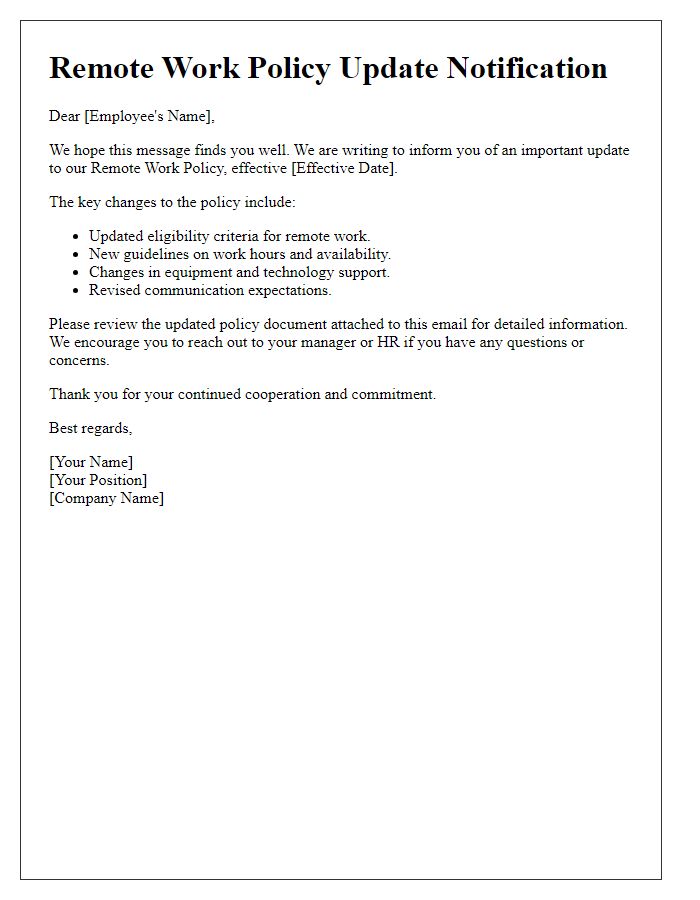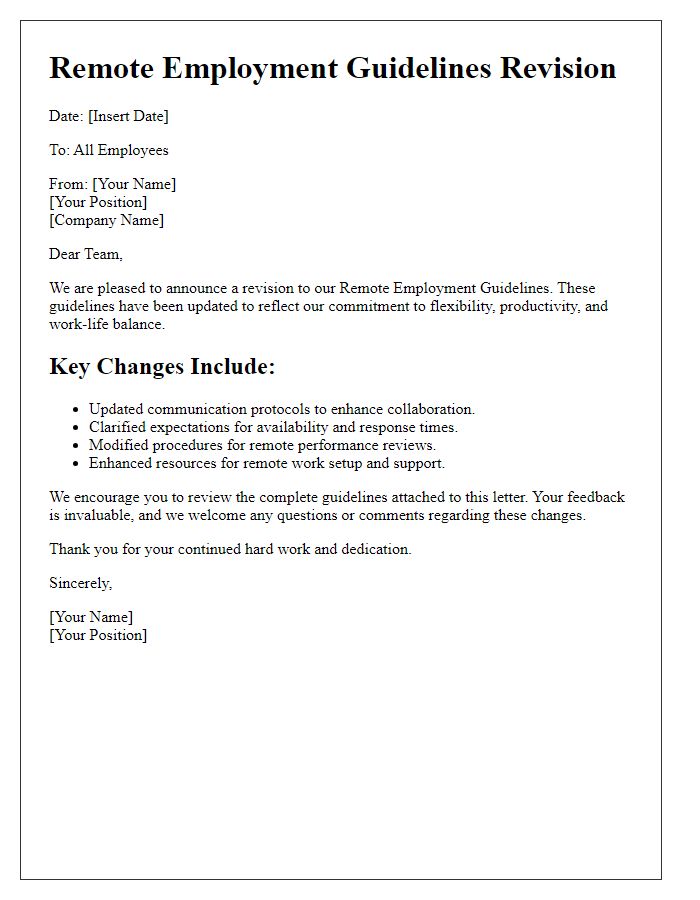In today's fast-paced world, many companies are embracing the flexibility of remote work, allowing employees to maintain a healthy work-life balance. As organizations navigate this shift, clear communication about remote work policies becomes essential for fostering a productive environment. This article will guide you through crafting a comprehensive remote work policy notice that keeps everyone informed and engaged. So, let's dive in and explore the key elements to include in your letter!

Clear Objectives
Remote work policies outline expectations and guidelines for employees working outside traditional office settings. Clear objectives help ensure alignment and productivity among team members. Effective communication channels, such as video conferencing tools like Zoom or Microsoft Teams, should be established to facilitate collaboration. Regular check-ins, often scheduled weekly, allow for tracking progress on tasks and projects. Key performance indicators (KPIs) must be defined to measure output and quality of work consistently. Additionally, deadlines must be specified clearly to enhance accountability and maintain workflow efficiency in remote environments.
Eligibility Criteria
Eligibility criteria for remote work arrangements within a corporate environment include several key factors ensuring a productive and compliant work setting. Employees must demonstrate a proven track record of reliability and effectiveness, typically evidenced by performance evaluations from the past year. Additionally, team roles directly impacting customer service, such as those in sales or support, are often ineligible due to the necessity of face-to-face interaction. The ability to maintain seamless communication through digital platforms like Slack or Microsoft Teams is essential for remote work success. Furthermore, companies may set specific tenure requirements, often ranging from six months to one year, to qualify for work-from-home privileges. Requirements related to employee equipment, such as secured Wi-Fi connections and functional hardware, also play a crucial role in determining eligibility for remote status, ensuring data protection and operational efficiency.
Communication Tools
Effective communication tools play a critical role in the productivity of remote teams, especially during transitions to fully remote work environments. Platforms such as Slack and Microsoft Teams facilitate real-time messaging, reducing response times significantly compared to traditional emails. Video conferencing tools, like Zoom, enable face-to-face interactions that enhance collaboration, offering capabilities for screen sharing and recording sessions to revisit discussions. Project management software, such as Asana or Trello, allows team members to track progress on tasks efficiently, ensuring everyone is aligned on project statuses and deadlines. Utilizing these tools fosters a connected culture, crucial for maintaining team morale and engagement in a virtual workspace.
Productivity Metrics
Remote work policies are crucial for maintaining high performance in virtual settings. Productivity metrics define clear expectations, helping employees gauge their effectiveness. Common metrics include project completion rates, response times to team communications, and the quality of deliverables assessed through peer reviews. These measures ensure accountability while allowing flexibility in work hours. Regular check-ins, typically weekly, provide opportunities for feedback, fostering a culture of continuous improvement. Implementing tools such as project management software assists in tracking progress, offering transparency for teams and management alike. This structured approach to productivity empowers employees to stay focused and engaged, even when working from home.
Compliance Guidelines
Remote work policies encompass several compliance guidelines essential for maintaining productivity and ensuring a safe working environment. Companies, such as TechCorp (founded in 2002), often establish clear expectations regarding employee conduct, communication protocols, and data security measures. Remote workers must adhere to industry regulations like GDPR (General Data Protection Regulation) when handling personal data, particularly in tech-driven firms based in the European Union. Regular check-ins using platforms like Zoom or Microsoft Teams may be required to foster collaboration, while proper use of VPN (Virtual Private Network) services will ensure protected internet connections. Additionally, employers often mandate ergonomic assessments to reduce workplace injuries, especially as studies show 67% of remote employees report discomfort due to improper setup. Compliance with these guidelines fosters a responsible and efficient remote work culture.













Comments